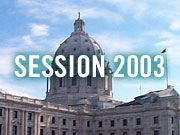Budget cut reaction: It's only a warm-up
January 14, 2003
Gov. Tim Pawlenty's plan to bridge the state's current $356 million deficit has touched off a chorus of protest from some corners of the Capitol. One of the larger items on the chopping block is the state's subsidy to ethanol producers, which is slated for complete elimination for the remainder of the biennium. Higher education, state agencies, and a business tax break would also suffer.
St. Paul, Minn. — Gov. Pawlenty warned that righting the state's fiscal ship wouldn't be easy. He warned it wouldn't be painless. But Sen. Dallas Sams, DFL-Staples, says he had no idea it would sink the state's subsidy to ethanol producers.
"We made a committment to these farmers and to the ethanol plants across rural Minnesota. And without this funding, they'll be... I don't know how many could survive, to be honest with you," he said.
Sams, who chairs the Senate committee overseeing agriculture funding, says he was shocked by the $27 million ethanol cut, a cut that completely eliminates the program through the rest of the year. He and industry representatives say the move could prove fatal to some plants, and they've vowed to fight the cuts during the legislative debate.
Another $50 million would come from higher education, to be split evenly between the University of Minnesota and the Minnesota State Colleges and University System. Officials with both systems say they understand the need to make sacrifices, but they say warn the cuts could lead to future tuition increases.
And that has students worried.
"We've had three years of tuition of increases," notes Yorgun Marcel, chair of the Minnesota State University Student Association. "As you know, as you've probably heard earlier this year, our child care and work study were drastically cut, if not almost virtually eliminated. And so we're looking at students who have already dealt with the brunt of this deficit. We've already dealt with it. We've already taken our share of the cut to a certain extent."
The Pawlenty plan would also call for a roughly 4 percent overall cut in state agency budgets.
Peter Benner, the executive director of the state's largest public employees union -- the American Federation of State, County, and Municipal Employees, Council 6 -- says he can't quarrel with the need to trim state government, but he did raise his eyebrows at one reform.
The governor would allow agency heads to require workers to take unpaid time off to ease the budget pain. Benner says the administration has no authority to do so. Benner says union members are open to discussing a plan for voluntary time off or reduced hours.
"Between a seriously pushed voluntary program, and then you don't buy the computers you haven't bought yet. You don't send people to the conferences you haven't sent them to yet. You really look at travel and things like that. They can get to the numbers they need to get," Benner said.
Pawlenty's plan would make Minnesota businesses wait for certain tax refunds, delaying those payments into the next budget cycle.
David Olson, president of the Minnesota Chamber of Commerce, says he's not entirely happy with the delayed payments, but he says the administration appears to be on the right track.
"We knew it wasn't going to be easy, and we knew this was the first cut. It looks to us like everybody got nicked a little bit, and we've been predicting that since the beginning. Everybody's going to pay a price to fix this deficit. And clearly the business community did on this one," he said.
Olson says despite concerns over the current proposal, he and others have their eyes on bigger challenge: a potential $4.5 billion deficit in the next biennium. And the governor is keeping the same perspective. He emphasized that despite the alarms raised by some, all Minnesotans would eventually share the budget-balancing burden.
"It's like the parents who are already working two jobs, and the demands keep coming forward from the family in terms of spending. At some point we can't ask the taxpayers to get another job," Pawlenty said.
House Republicans have already called for swift passage of the governor's plan, with some possibly minor adjustments. DFLers in the Senate say they, too, want to reach quick consensus.
|
News Headlines
|
Related Subjects
|

